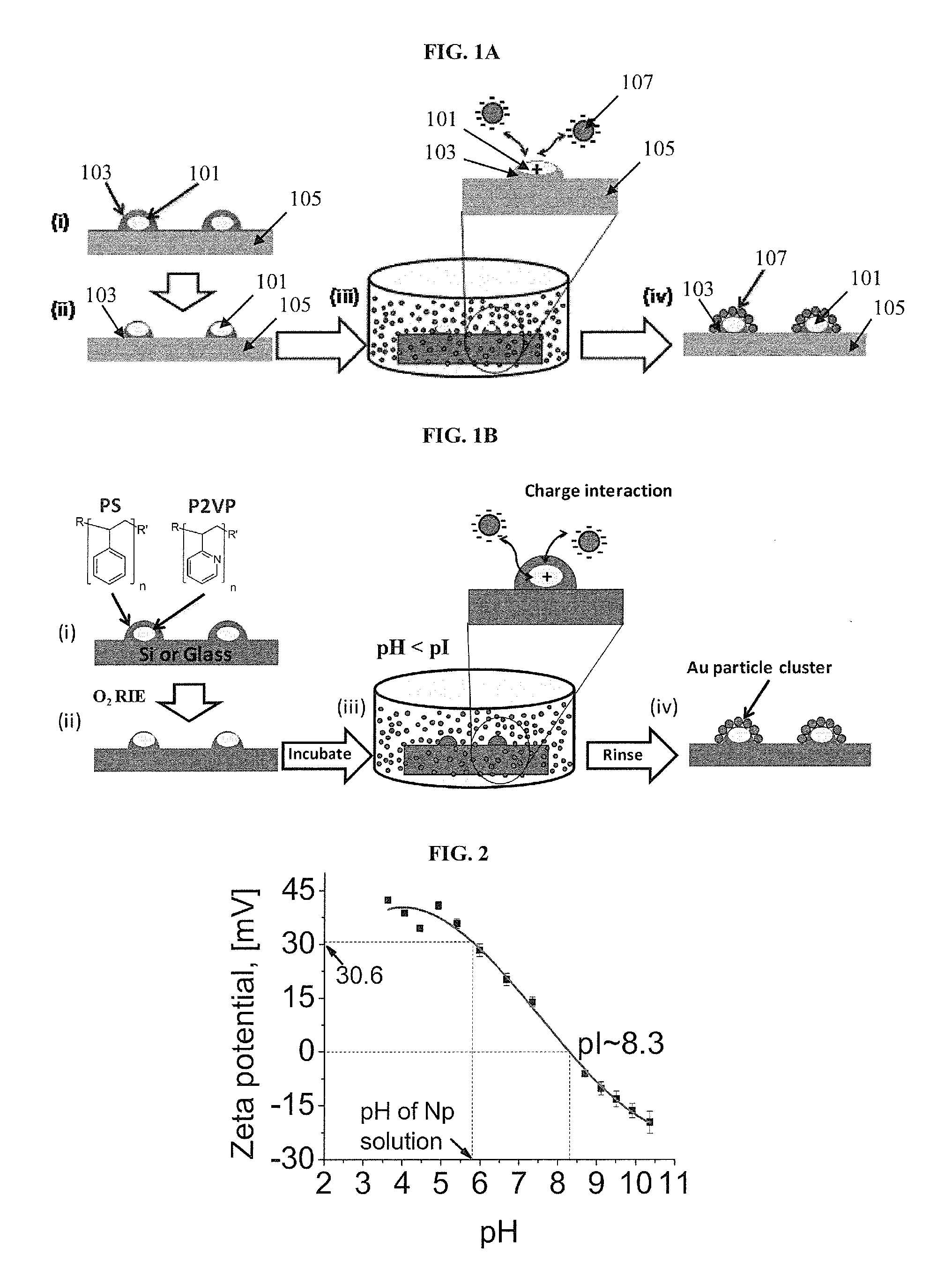Methods to form substrates for optical sensing by surface enhanced raman spectroscopy (SERS) and substrates formed by the methods
a technology of substrates, which is applied in the field of methods of forming substrates for optical sensing by surface enhanced raman spectroscopy, and to substrates formed by the methods, can solve the problems of limited commercialization of sers techniques, amplification of signal intensity, and non-uniform enhancement of state-of-the-art sers substrates
- Summary
- Abstract
- Description
- Claims
- Application Information
AI Technical Summary
Benefits of technology
Problems solved by technology
Method used
Image
Examples
example 1
Materials
[0116]Polystyrene-block-poly(2-vinylpyridine) (PS-b-PVP) (57000-b-57000 g / mol) was purchased from Polymer Source Inc. (Montreal, Canada). Silicon and quartz substrates were purchased from Silicon Valley Microelectronics (SVM, CA, USA). (3-Aminopropyl) trimethoxysilane (APTMS, 95%) and crystal violet (CV, FW: 407.99) were purchased from Sigma-Aldrich. Hexane, ethanol (both analytical grade), hydrochloric acid (HCl, 37%), nitric acid (HNO3, 65%), sulphuric acid (H2SO4, 95-97%) and hydrogen peroxide (H2O2) were purchased from Merck. Optical fibers with 1000 μm diameter and 0.37 numerical aperture having a hard polymer cladding with silica core was purchased from Thorlabs (BFH37-1000, fiber ID F10-056T).
example 2
[0117]The zeta potential of the surface coated with micelle arrays was determined by streaming potential measurements using SurPASS electro-kinetic analyzer (Anton Par, VA, USA). Electrophoretic measurements on gold nanoparticles were carried out using Zetasizer Nano ZS (Malvern, Worcestershire, UK). The samples used for the measurement measured 20 mm×10 mm. The templates, nanoparticle clusters, and the unpatterned gold nanoparticles were characterized with tapping mode AFM (Nanoscope IV Multimode AFM, Veeco Instruments Inc., NY, USA), SEM (FESEM 6700F, JEOL, Tokyo, Japan) and TEM (Philips CM300) operating at 300 kV. The extinction spectra of the gold nanoparticles assembly on glass substrates were recorded using CRAIC Spectrophotometer (CRAIC Technologies, CA, USA). An unpolarized light source was used with measurement spot areas of 77 μm×77 μm.
example 3
Preparation of Fiber Substrates
[0118]The fibers were cut into 10 cm pieces by a cleaver. The jacket and cladding were stripped to a length of approximately 1.5 cm from each end. Both ends were then polished using alumina polishing sheets (1 μm) using standard techniques. The polished ends were then washed for about 2 to 3 minutes with a jet of water and sonicated in ethanol for 10 minutes and dried.
PUM
| Property | Measurement | Unit |
|---|---|---|
| inter-particle distance | aaaaa | aaaaa |
| inter-particle distance | aaaaa | aaaaa |
| inter-particle distance | aaaaa | aaaaa |
Abstract
Description
Claims
Application Information
 Login to View More
Login to View More - R&D
- Intellectual Property
- Life Sciences
- Materials
- Tech Scout
- Unparalleled Data Quality
- Higher Quality Content
- 60% Fewer Hallucinations
Browse by: Latest US Patents, China's latest patents, Technical Efficacy Thesaurus, Application Domain, Technology Topic, Popular Technical Reports.
© 2025 PatSnap. All rights reserved.Legal|Privacy policy|Modern Slavery Act Transparency Statement|Sitemap|About US| Contact US: help@patsnap.com



